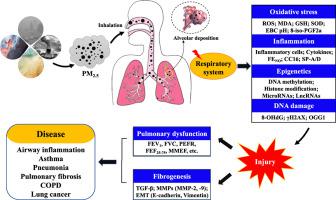Journal of Hazardous Materials ( IF 12.2 ) Pub Date : 2021-07-27 , DOI: 10.1016/j.jhazmat.2021.126760 Caixia Guo 1 , Songqing Lv 2 , Yufan Liu 2 , Yanbo Li 2

|
Large amounts of epidemiological evidence have confirmed the atmospheric particulate matter (PM2.5) exposure was positively correlated with the morbidity and mortality of respiratory diseases. Nevertheless, its pathogenesis remains incompletely understood, probably resulting from the activation of oxidative stress, inflammation, altered genetic and epigenetic modifications in the lung upon PM2.5 exposure. Currently, biomarker investigations have been widely used in epidemiological and toxicological studies, which may help in understanding the biologic mechanisms underlying PM2.5-elicited adverse health outcomes. Here, the emerging biomarkers to indicate PM2.5-respiratory system interactions were summarized, primarily related to oxidative stress (ROS, MDA, GSH, etc.), inflammation (Interleukins, FENO, CC16, etc.), DNA damage (8-OHdG, γH2AX, OGG1) and also epigenetic modulation (DNA methylation, histone modification, microRNAs). The identified biomarkers shed light on PM2.5-elicited inflammation, fibrogenesis and carcinogenesis, thus may favor more precise interventions in public health. It is worth noting that some inconsistent findings may possibly relate to the inter-study differentials in the airborne PM2.5 sample, exposure mode and targeted subjects, as well as methodological issues. Further research, particularly by -omics technique to identify novel, specific biomarkers, is warranted to illuminate the causal relationship between PM2.5 pollution and deleterious lung outcomes.
中文翻译:

与大气颗粒物暴露相关的对呼吸系统健康不利影响的生物标志物
大量流行病学证据证实,大气颗粒物(PM 2.5)暴露与呼吸系统疾病的发病率和死亡率呈正相关。然而,其发病机制仍不完全清楚,可能是由于暴露于 PM 2.5 后肺中氧化应激、炎症、改变的遗传和表观遗传修饰的激活所致。目前,生物标志物研究已广泛用于流行病学和毒理学研究,这可能有助于理解 PM 2.5引起的不良健康结果的生物学机制。在这里,指示 PM 2.5的新兴生物标志物- 总结了呼吸系统相互作用,主要与氧化应激(ROS、MDA、GSH 等)、炎症(白介素、FE NO、CC16 等)、DNA 损伤(8-OHdG、γH2AX、OGG1)以及表观遗传有关调制(DNA 甲基化、组蛋白修饰、microRNA)。鉴定出的生物标志物阐明了 PM 2.5引发的炎症、纤维化和致癌作用,因此可能有利于对公共卫生进行更精确的干预。值得注意的是,一些不一致的发现可能与空气中 PM 2.5 的研究间差异有关样本、曝光模式和目标对象,以及方法问题。进一步的研究,特别是通过组学技术来识别新的、特定的生物标志物,有必要阐明 PM 2.5污染与有害肺部结果之间的因果关系。











































 京公网安备 11010802027423号
京公网安备 11010802027423号